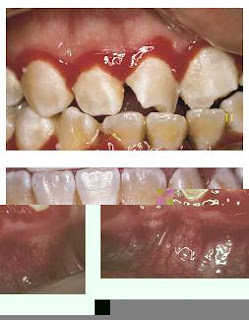Etiology • Variable • Most are microbiologic or plaque associated (simple marginal
gingivitis). • Some are modified by hormonal changes, such as those in
pregnancy (pregnancy gingivitis). • Fusospirochetal gingivitis plus poor oral hygiene and poor nutri-
tion are associated with acute necrotizing ulcerative gingivitis. • Rarely, some forms are associated with contact allergy (“plasma
cell gingivitis”).
Clinical Presentation • Dependent on etiology, as follows:
gingivitis). • Some are modified by hormonal changes, such as those in
pregnancy (pregnancy gingivitis). • Fusospirochetal gingivitis plus poor oral hygiene and poor nutri-
tion are associated with acute necrotizing ulcerative gingivitis. • Rarely, some forms are associated with contact allergy (“plasma
cell gingivitis”).
Clinical Presentation • Dependent on etiology, as follows:
• Plaque associated: marginal inflammation to more generalized erythema and blunting of interdental papillae with rolled margins
• Hormonally related: diffuse erythema and hyperplasia • Fusospirochetal: necrotic, blunted, ulcerated interdental
papillae with spontaneous bleeding; foul odor • Allergy based: hyperplastic and bright red, granular to
velvety surface alteration
Diagnosis • Identification of cause • Patch testing for contact allergens
Differential Diagnosis • Acquired immunodeficiency syndrome–associated periodontal
disease • Oral lichen planus • Mucous membrane (cicatricial) pemphigoid • Acute herpetic gingivostomatitis • Pemphigus vulgaris
Treatment • Local débridement and chlorhexidine rinses in cases of bacterial
origin • Reduction of hormonal dosage • Elimination of allergen
Prognosis • Excellent
origin • Reduction of hormonal dosage • Elimination of allergen
Prognosis • Excellent
